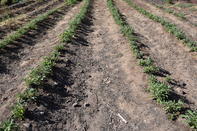Propagation
Propagation is from seed but sage can also be propagated by planting cuttings or by layering. Seed planting takes longer and the plants can end up being uneven. It is best to seed into trays in a greenhouse so that uniform seedlings can be planted out.

To plant and produce sage cuttings take 20 cm cuttings from fresh growth tips and strip the lower leaves off the cutting, and place in water with the lower stripped portion submerged. Once you have the required amount of cuttings, ready the plant medium.
This is normally a mixture of sand and a potting mixture in a 500 ml plant bag. Dip the wet tips into a plant hormone mix and plant into the plant medium. A few weeks later they will have roots and when the sage seedlings are growing well they are planted out.
Planting Method
Sage planting by large commercial growers is more commonly done by planting seedlings that have been produced in a greenhouse. The sage seeds are planted into seedling trays about 8 to 10 millimetres deep.
Once the seeds have germinated and strong seedlings have grown these are planted out into the fields. Once the blocks are established it is a good practice to start making plants from cuttings for planting in, for when plants are lost and create gaps in the plant rows.
Spacing
Sage plants normally grow into a ball shape about 650 mm high and a diameter of 500 mm and 600 mm. When planting, the seedlings should be spaced 30 cm apart in rows that are 50 cm or 60 cm apart.
This is a stand of around 50 000 to 60 000 plants per hectare. Depending on the vehicles and harvest methods, implement and tractor paths are left for management practices and harvesting.
Sowing Time
Sow seeds into seed trays in a protected environment or greenhouse during June in South Africa, and by early spring the sage seedlings should be strong enough to plant out into the fields.
Planting Time
The best time to plant sage seedlings is in early spring. In South Africa that is late August to early September. If early autumn is warm enough, planting can take place then, as long as the plants can settle in and are growing strong before the winter cold sets in.
Growth Period
Six to ten weeks in the greenhouse should produce strong enough sage seedlings that are ready to plant out. Some producers start harvesting from as early as four months from planting out the seedlings.
Care should be taken not to over harvest in the first year as this could stress the sage plant. Full harvesting will commence in the summer of the second year. Sage plants can be harvested for up to 6 years or more if managed properly. From the second year, the plants are pruned back to about 10 cm above the ground in early spring.
Fertilization
Before planting commences, a representative soil sample should be taken and sent for analysis. This will identify soil type and the nutrient requirements for the sage plants to thrive.
The following recommendation can be used as an average programme. An initial 300 kg per hectare application of 2:3:4 (31) can be broadcast and incorporated into the top 20 cm of soil prior to planting the sage seedlings. This will give the new seedlings a good start in establishing themselves.
During the first 12 months, it is important to keep the plants growing so a further application of 300 kg of 2:3:4 (31) can be applied along the plant rows, in December or January after harvesting. It is advisable to fertilise after every harvest. It is very important to not over-fertilise with nitrogen as this reduces the potency of the aroma and oils in the leaves.
Irrigation
Although the sage plant is considered a hardy and water-wise plant it is not good to stress the plant by under irrigating and effecting plant growth and production or over irrigating, which could cause root diseases.
It is, therefore, best to install moisture measuring devices to continuously monitor the soil water content.
Depending on soil types and the weather, irrigation volumes will differ from field to field. A good average is between 20 and 30 mm per week during the warm summer months and reducing during cooler or rainy months of the year.
As with other oily herbs, try to not water for the week before harvest. It is good to irrigate immediately after harvest to bring soil back to optimum moisture content. It is important to let the soil drain well through the root profile and for the surface, top 5 cm, to dry out before watering.